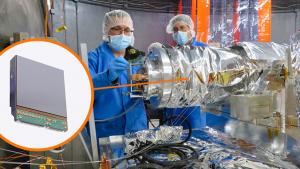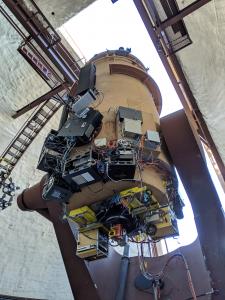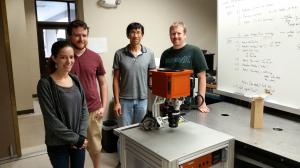Astronomy at UH plays key role in 30 years of NSF instrumentation funding
University of Hawaiʻi at MānoaAstronomer , Institute for Astronomy
Roy Gal, (808) 388-8690
Associate Astronomer, Institute for Astronomy
For more than three decades, technology development at the University of Hawaiʻi Institute for Astronomy (IfA) has been a prime mover in federally funded astronomy programs, according to a study published in the Journal of Astronomical Telescopes, Instruments, and Systems. The authors tracked the impact of National Science Foundation (NSF) grants for astronomy technology and instrumentation development over the last 30 years.
From world-class infrared imaging to groundbreaking laser optics, IfA’s cutting-edge devices funded by NSF have had major impacts on the field of astronomy. “The IfA is a powerhouse of astronomical instrumentation—fueled in large part by funding from the forward-looking NSF ATI [Advanced Technologies and Instrumentation] program,” explained IfA Astronomer Christoph Baranec. “The key new technologies that are developed at the IfA enable scientific breakthroughs, create unique training opportunities, and pave the way for other major facilities around the world and in space.”
IfA projects supported by the NSF ATI program
Baranec developed the very first autonomous laser adaptive optics (AO) system and science instrument. The Robo-AO system is able to correct image distortion due to Earth’s atmosphere and execute large surveys robotically. It’s funded by the NSF ATI program and is “the most widely acknowledged ATI award” in the history of the program. Baranec is now deploying its successor, Robo-AO-2, also supported by ATI, on the UH 2.2-m telescope on Maunakea.
IfA received a $7 million grant, the largest single ATI award to date, to support development of the HAWAII 4RG mosaic camera, which has become the gold standard in infrared imaging, and will soon be in use at almost all major ground-based observatories. The device will also be utilized in many upcoming space missions including the Euclid and Nancy Grace Roman space telescopes.
Other ongoing ATI-funded projects on Maunakea include ʻIMAKA, an adaptive optics system that corrects atmospheric image distortion over a much larger area than previously possible. ATI recently funded a new deformable secondary mirror for the UH 88-inch telescope that will be the first of its kind on a major telescope. Additionally, the ATI program has funded work to improve the exoplanet imaging capabilities of the W. M. Keck Observatory using optical techniques originally designed for space telescopes. One award, supported the development of a novel near-infrared pyramid wavefront sensor for Keck Observatory’s AO system, built by Charlotte Bond, Mark Chun and Don Hall at IfA.
"The NSF ATI program has been a key supporter of new instrumentation, which has proven transformative on many occasions. The funding we received this year will not only help advance the field, but will let us train the next generation of instrumentalists here in Hawaiʻi," said IfA Astronomer Michael Bottom, recipient of the most recent award.
Impacts of funding
According to the study, ATI grants have provided many early career researchers the opportunity to gain critical professional experience, but technology development unfolds over a time period that is longer than an individual grant. It noted that investments in technology and instrumentation can lead to exceptional scientific progress.
Long-term impacts are seen in ATI awards from the 1980s and 1990s, a period notable for disseminating charged-coupled device (CCD) cameras to astronomical observatories for research and teaching. Maunakea was one of the observatories to receive CCD cameras through ATI awards in this time period.
In the 1980s, the IfA was already a major player in the development of adaptive optics for astronomy. Innovative approaches to wavefront sensing and control, the curvature sensor and bimorph mirror, were developed during this time. ATI awards to former IfA researcher Francois Roddier partially supported the deployment of this technology at the Canada-France-Hawaiʻi Telescope on Maunakea, and its use to study circumstellar environments and protoplanetary disks. The technology was later adopted by the 8-m Subaru Telescope, also on Maunakea. ATI supported the development of laser guide stars and the deployment of AO instrumentation on Maunakea.
IfA Interim Director Robert McLaren noted, “This report confirms that the IfA is a world leader in astronomical instrumentation, and the ATI program has played a major role, bringing funding, expertise and training opportunities to Hawaiʻi. It is a great example of just how important astronomy has been, and will continue to be to the future of our state.”
About the Institute for Astronomy
Founded in 1967, the Institute for Astronomy at the University of Hawaiʻi at Mānoa conducts research into galaxies, cosmology, stars, planets, and the sun. Its faculty and staff are also involved in astronomy education, deep space missions, and in the development and management of the observatories on Haleakalā and Maunakea. The Institute operates facilities on the islands of Oʻahu, Maui, and Hawaiʻi.
About the National Science Foundation
The National Science Foundation (NSF) is an independent federal agency created by Congress in 1950 "to promote the progress of science; to advance the national health, prosperity, and welfare; to secure the national defense..." NSF is vital because it supports basic research and people to create knowledge that transforms the future. This type of support: Is a primary driver of the U.S. economy, enhances the nation's security, advances knowledge to sustain global leadership. With an annual budget of $8.3 billion (FY 2020), NSF is the funding source for approximately 25 percent of all federally supported basic research conducted by America's colleges and universities. In many fields such as mathematics, computer science and the social sciences, NSF is the major source of federal backing.
About the Advanced Technologies and Instrumentation Program
The Advanced Technologies and Instrumentation (ATI) program provides individual investigator and collaborative research grants for development of new technologies and instrumentation for astronomy and astrophysics. The program supports overarching science objectives of the Division of Astronomical Sciences. Development of innovative, potentially transformative technologies are encouraged, even at high technical risk. Supported categories include but are not limited to: advanced technology development or concept feasibility studies and specialized instrumentation to enable new observations that are difficult or impossible to obtain with existing means. Proposals may include hardware and/or software development and/or analysis to enable new types of astronomical observations. The program encourages making products of research available to the public. It also encourages community coordination of technology and instrumentation development efforts via an annual Principal Investigators meeting.



